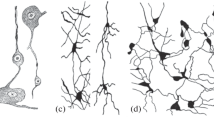Abstract.
Filamentous contacts are non-synaptic interneuronal junctions characteristic of thalamic relay nuclei. Symmetrical filamentous contacts occur between two dendrites, two somata or a dendrite and a soma; asymmetrical filamentous contacts occur between axon terminals and dendrites, or occasionally somata, chiefly between the large specific afferent axon terminals of the synaptic glomeruli and the shafts of relay cell dendrites. Both are arranged as extensive net-like (reticular) specializations. The strands of the network enclose fenestrae of variable shape and size and, in perpendicular thin sections, appear as stretches of slightly widened intercellular space containing an electron-dense material and bounded by plasma membranes, the cytoplasmic surfaces of which are coated by electron-dense material into which microfilaments appear to insert. The lamina of cytoplasmic material in dendrites and somata is thicker than that in axon terminals and contains distinct electron-dense sub-units. Regular synaptic junctions may be situated like islands within the territory of an asymmetrical filamentous contact, and small spot-like close membrane appositions resembling gap junctions are occasionally seen in the fenestrae adjacent to the strands of both varieties of contact. Bundles of neurofilaments running in different directions, but in a plane parallel to the plasma membrane, are prominent on either side of the symmetrical filamentous contact and on the dendritic side of the asymmetrical variety. The agranular reticulum also exhibits differences between the contact types. Because of their highly specialized ultrastructure and specific distribution, filamentous contacts probably do not serve a purely adhesive function. Their possible role in the establishment and maintenance of orderly connections between cells is discussed but not favoured. Filamentous contacts probably mediate some form of intercellular communication, possibly involving gap junctions.
Similar content being viewed by others
Author information
Authors and Affiliations
Additional information
Received: 2 July 1996 / Accepted: 11 October 1996
Rights and permissions
About this article
Cite this article
Lieberman, A., Špaček, J. Filamentous contacts: the ultrastructure and three-dimensional organization of specialized non-synaptic interneuronal appositions in thalamic relay nuclei. Cell Tissue Res 288, 43–57 (1997). https://doi.org/10.1007/s004410050791
Issue Date:
DOI: https://doi.org/10.1007/s004410050791



